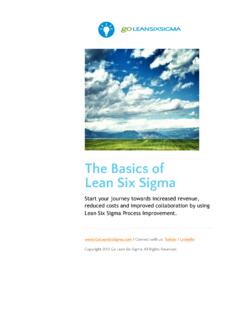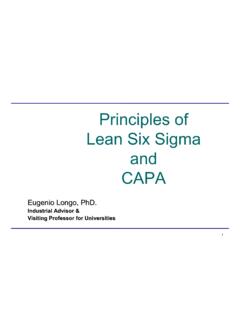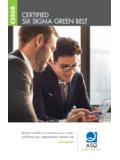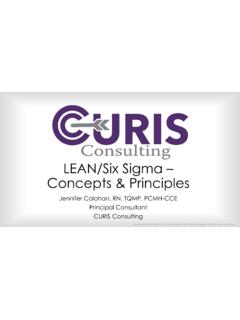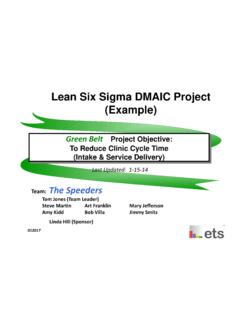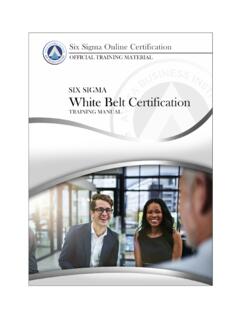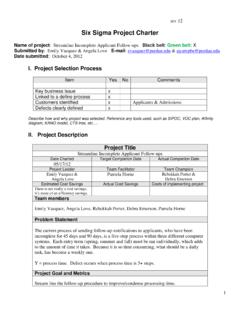Transcription of Results - Lean
1 ResultsEnterprise AlignmentContinuous ProcessImprovementCultural EnablersCreate Constancy of PurposeThink SystemicallyFocus on ProcessEmbrace Scientific ThinkingFlow & Pull ValueAssure Quality at the SourceSeek PerfectionLead with HumilityRespect Every IndividualCreate Value for the CustomerSee RealityFocus on Long-termAlign SystemsAlign StrategyStandardize Daily ManagementStabilize ProcessesRely on Facts & DataStandardize ProcessesInsist on Direct ObservationFocus on Value StreamKeep it Simple & VisualIdentify & Eliminate WasteNo Defects Passed ForwardIntegrate Improvement with WorkAssure a Safe EnvironmentDevelop PeopleEmpower & Involve EveryoneMeasure what MattersAlign Behaviors with PerformanceIdentify Cause & Effect Relationships The Shingo PrizeGUIDING PRINCIPLESSUPPORTING CONCEPTSSUPPLYOPERATIONSCUSTOMERRELATION SPRODUCT &SERVICEDEVELOPMENTADMINISTRATIONTHE SHINGO MODEL 1 MissionVisionThe mission of The Shingo Prize for Operational Excellence is to create excellence in organizations through the application of universally accepted principles of operational excellence, alignment of management systems and the wise application of improvement techniques across the entire organizational enterprise.
2 We do this by teaching correct principles and new paradigms that accelerate the flow of value, align and empower people and transform organizational culture. Our vision is to be the global standard of excellence in every industry; because The Shingo Prize roots are in organizational recognition, we have learned three very important principles:Key insights from 25 years of organizational assessment1. Evaluating organizations for recognition requires a clearly defined, very high and universally consistent standard of True excellence cannot be fleeting; therefore, assessment must determine the degree to which the principles that create excellence are deeply embedded into For any organization to be successful, they must be able to see the truth about where they are in the development of a high-performing, principle-based culture. 2 Select organizations with whom The Shingo Prize for Operational Excellence has engaged:HealthcareChristie ClinicCleveland ClinicDenver HealthLehigh Valley HealthcareThedaCare Center for Healthcare ValueToyota Memorial HospitalMartin s Point Health CareServiceExport Development Bank of ScotlandState Farm Life InsuranceStephen Covey GroupVerizonULManufacturingAutolivThe Boeing CompanyBoston ScientificBaxter HealthcareCaterpillar Land RoverJohn DeereJohnson & JohnsonLeyland Trucks Lockheed MartinLundbeckOC TannerPentairRexam US SyntheticVisteonTHE SHINGO MODEL 3 Dear colleagues and friends,In my associations, many people have asked the following questions: How did The Shingo Prize come about?
3 How has it arrived where it is today? And what does the organization actually do?As we release this new book, I d like to take the opportunity to tell you the brief version of our story. My hope is that the given context will provide you with additional value as you study the Shingo model and implement it as part of your organization s cultural BeginningFew individuals have contributed as much to the development of the ideas we call TQM, JIT and lean as did Shigeo Shingo. Over the course of his life, Dr. Shingo wrote and published 18 books, eight of which were translated from Japanese into English. Many years before they became popular in the Western world, Dr. Shingo wrote about the ideas of ensuring quality at the source, flowing value to customers, working with zero inventories, rapidly setting up machines through the system of single-minute exchange of dies (SMED) and going to the actual workplace to grasp the true situation there.
4 He worked extensively with Toyota executives, especially Mr. Taiichi Ohno, who helped him to apply his understanding of these concepts in the real on the leading edge of new ideas, Dr. Shingo envisioned a collaboration with an organization that would further his life s work through research, practical-yet-rigorous education and a program for recognizing the best in operational excellence throughout the world. In 1988, Shingo received his honorary Doctorate of Management from Utah State University and, later that year, his ambitions were realized when The Shingo Prize for Excellence in Manufacturing was organized and incorporated as part of the university. In 2007, the organization was renamed The Shingo Prize for Operational Excellence due to its relevance within every industry not exclusively the area of manufacturing. Guiding Principles and Shifting ParadigmsOne of Dr. Shingo s little known, but perhaps most important contributions, was his understanding of the relationship between concepts (principles), systems and tools.
5 Unfortunately, over the years, most of us have gravitated to and exalted the tools associated with effective operations and have paid too little attention to the power of the principles. Dr. Shingo taught that understanding the principles behind the tools leads to higher-order thinking and answers the question, why? When people Forward 4understand more deeply the why behind the how and the what, they become empowered to innovate and take individual initiative. As more and more people within a single organization begin to act independently based on their understanding and commitment to the principles, culture begins to shift. This fundamental truth is the basis for The Shingo Prize and the Shingo on the work of Dr. Shingo, the mission of The Shingo Prize is to assist organizations of all kinds to create lasting cultures of operational excellence. We achieve our mission by focusing our efforts on timeless and universal part of our efforts, we teach five fundamental paradigm shifts:1.
6 Operational excellence requires a focus both on Results and Ideal behaviors in an organization are those that flow from the principles that govern the desired Principles construct the only foundation upon which a culture can be built if it is to be sustained over the Creating ideal, principle-based behaviors requires alignment of the management systems that have the greatest impact on how people The tools of lean , TQM, JIT, Six sigma , etc. are enablers and should be strategically and cautiously inserted into appropriate systems to better drive ideal behavior and excellent Results . All Shingo recognition is based on the degree to which these paradigms are broadly understood and deeply embedded into the behavioral fabric of an organization, top-to-bottom and Shingo Standard: A StoryThe Shingo standard is, by design, the most rigorous in the world. We believe Dr. Shingo would only want to associate his name with the very best.
7 Applicants for recognition are held to an identical standard no matter where they are located in the world. Our standard has not always been so high. For 18 years The Shingo Prize evaluated organizations by noting their application of lean tools, the quality of their lean program deployment and, to some degree, the engagement of their management teams. This process consistently resulted in eight to 10 organizations receiving The Shingo Prize each year. All was fine until we realized that it wasn began to see small signs of fracture along the edges. Critics of our selection process began to emerge in blogs and websites and eventually began to confront us directly. There is an adage that states, Your best friends are the ones that tell you the truth, even when it is hard to hear. THE SHINGO MODEL 5 Fortunately, we had very good friends in the Association for Manufacturing Excellence (AME) and the Society of Manufacturing Engineers (SME).
8 They told us they were beginning to lose confidence in recommending, carte blanche, our recipients as benchmarking sites for their members. As much as this hurt, it forced us to begin a deep and earnest assessment of our past recipients; specifically, which ones had sustained their improvements and which ones had lost ground. Our findings were alarming!We learned that even the best of the best had an extremely difficult time sustaining the gains we had observed during their assessments. Furthermore, we discovered that our assessment criteria had two major flaws: (1) our standard for what excellence looked like was based too much on outward appearance and not enough on the deeply embedded culture of the organization, and (2) we did not know how to accurately evaluate and measure the truth regarding an organization s culture. Our insights sparked a yearlong study to determine what did and did not work in sustaining improvement efforts and to understand the reasons behind success or failure.
9 At the same time, we began to dig back through all of Dr. Shingo s books to see if we could discover what it was that we were missing. To our surprise and delight, working from either end and toward the middle, we arrived at a unanimous conclusion. The difference between successful and unsuccessful efforts was always in the organizations ability to get past the tools, events and programs and to align management systems with principles. When such alignment took place, ideal behaviors followed and perpetuated a deep culture of operational excellence. Based on our findings, we developed the Shingo model that consists of an organized collection of guiding principles (the House) and a transformation process (the Diamond). Together, this framework has become the basis for everything we , Assessment and RecognitionThe Shingo Prize has three areas of focus: education, assessment and recognition. We teach leaders to better understand their role in building a culture of operational excellence and we teach managers how to better align systems to drive ideal, principle-based focus on assessment is not as much on awarding The Shingo Prize, but more on using the Shingo model as the basis for honest, self- and organizational-evaluation and initiating lasting improvements to the culture.
10 In fact, we often say that The True Shingo Prize is the culture of operational excellence that comes from a disciplined application of the Shingo model into your is given each year to successful challengers from around the world at the Annual Shingo Prize 6 International Conference & Awards Ceremony and Gala. Recipients may come from any industry and any part of the world. While many warned us that the standard was too high and, consequently, no organization would apply, we have found the opposite to be the case. Every year we have more and more applications for assessment and recognition. While the number of recipients of The Shingo Prize has been reduced dramatically, we now recognize 10-20 companies each year for their progress toward building this highly coveted culture with either a Shingo Bronze or a Shingo Silver Medallion. I congratulate you and your organization on your commitment to improvement.
